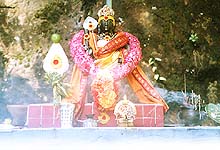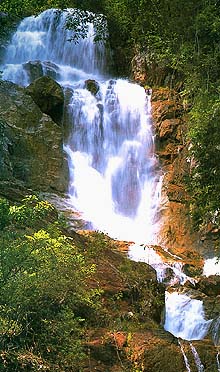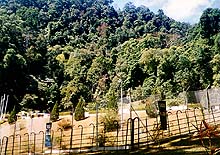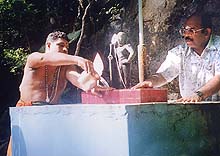

| The Secret Perch of Muruga (by Himanshu Bhatt) While Thaipusam celebrations in Penang are famously associated with the cluster of crowded temples in the Waterfall area, a small but powerfully significant landmark is existing quietly nigh, unrevealed to the public.  For the last two centuries, a little shrine - known only to a handful of people - has been lying hidden from public attention, in the dense forested hills behind the nearby Botanic Gardens. Every year about a week before Thaipusam, a small gathering of Hindu devotees makes an ascent to offer prayers at the shrine. The little-known event, held in the early morning, marks the beginning of the Thaipusam festivities. The group of worshippers comprises local community leaders and temple volunteers. What makes the ancient shrine even more significant is its location. It lies amid verdant greenery at the very base of one of Penang island's greatest natural landmarks - the Waterfall. The beautiful giant cascade is visible to the public only as a thin white strip as seen from a distance along the tarmac footpath of the Botanic Gardens. | |
 | The famous waterfall and the little shrine are both inaccessible to the public; but while the waterfall is known widely, the age-old shrine has been virtually unheard of. A couple of years ago, I had the privilege of accompanying the group of devotees during the annual incipient prayers for Thaipusam. The 25-odd worshippers, beating traditional drums and quivering trumpet music in the placid dawn, trekked up the hill behind the Waterfall Reservoir in the gardens. Carrying trays filled with flowers, garlands, coconuts, milk and other ceremonial items, the small procession took a walk up a long flight of steps built by the authorities along the hill some years ago. |
 Incidentally, the reservoir, located 232 feet above sea level, was first built by British engineer J. MacRitchie in 1892 and reconstructed some sixty years later. Today, the site of the waterfall and the shrine is under the purview of the Penang Water Authority, which operates the reservoir. We left whiffs of incense odour trailing our way towards the site. Witnessing the simple yet charming religious event was an engaging experience for me. The shrine is ensconced within low forested hills far behind the high barbed-wire fencing of the reservoir (right), and houses an ancient idol of the venerated Hindu god, Muruga - the mighty son of Lord Shiva. High up the dense vegetation, the site is unapproachable and prohibited to the public. As we walked up the hill surrounded by lush foliage, we could hear the torrent of the waterfall's plunge against the rocks become louder and louder, until the noise became a rich never-ending bellow of foam and water. We then walked over a small wooden bridge near the base of the fall, and stepped into a muddy level clearing alongside the waterfall's slope. There lay the shrine amid the rhythm and solitude of nature. The sight of the diminutive, sharply chiseled idol of Muruga is an arresting experience. The idol stands out instantly amid the thick vegetation. Muruga stands heroic and imperious like a proud peacock, one arm akimbo, the other holding a staff. A small spear (vel) strapped across his stately frame gleams in fresh sunlight like lightning. High above the idol, a dense reach of vegetation towers aloft like a protective overhanging parasol.  I then watched the worshippers perform a beautiful ritual of gently washing the idol and dressing the deity in ceremonial saffron robes. The drums and trumpets reverberated amid low unceasing vibrations of cicadas and birds. The heavy growth of fronds and thick boughs and the hanging wild vines appeared to welcome the annual guests in this spiritually charged natural setting. The image of Muruga lies next to a big iron Vel, the god's symbol, that is embedded in a concrete slab. The Vel is believed to have been placed there during the 1780s by Indian labourers used by the British to transport water from the waterfall to George Town. Apparently, the bottom section of the Vel was broken after some years. The Vel, however, has been kept at its place, but covered with concrete with only the top part showing. It is said that a Hindu monk was taken by the waterfall's setting and inspired the building of the shrine, when the Indian workers were transporting water towards George Town on bullock carts. The monk was not alone in being affected by the site. British Captain James Low wrote a lengthy article about the place in the 1830s. Charles Dyce also wrote: "The waterfall amply repays one for the scramble and loss of wind necessary to reach a convenient spot: once seated on some rocky ledge one feels disinclined to descend again and encounter the burning sun." According to an official notice near the base of the waterfall, early paintings and photographs showed an Indian shrine at the foot of the falls. Records also indicate an old Muslim grave of 'Chenana' on the hill above the waterfall, bearing his name. It is interesting to note that the waterfall has been one of the historical sources of water for George Town and ships that called at Penang. In fact, in 1805, an aquaduct was built from the waterfall via Pulau Tikus to a reservoir near Leith Street Ghaut and Hutton Lane respectively. For me, the experience of the morning was uplifting and singular. Trekking up the hill, witnessing the prayers and breathing the sprightly air of nature. I felt the site to be a consummation of deep spirituality, history and nature. An ancient religious monument, virgin greenery and the great waterfall nestled amid craggy vertical columns of sheer hillside. I could think of few places on Earth fit for the Lord Muruga, prince of righteousness and protector of the innocent, to perch with his solid omniscient smile, as he calmly regarded the world before him. * * * * * * The webmasters of Kaumaram.com sincerely thank Mr. Himanshu Bhatt for his kind permission to reproduce this article and pictures. Mr. Himanshu Bhatt is a journalist based in Penang, Malaysia. Other articles in Kaumaram.com by the same writer: Faith Across Cultures On the Crest of Prayer | |

Kaumaram.com is a non-commercial website. This website is a dedication of Love for Lord Murugan. Please take note that Kaumaram.com DOES NOT solicit any funding, DIRECTLY or INDIRECTLY. [xhtml] .[css] |